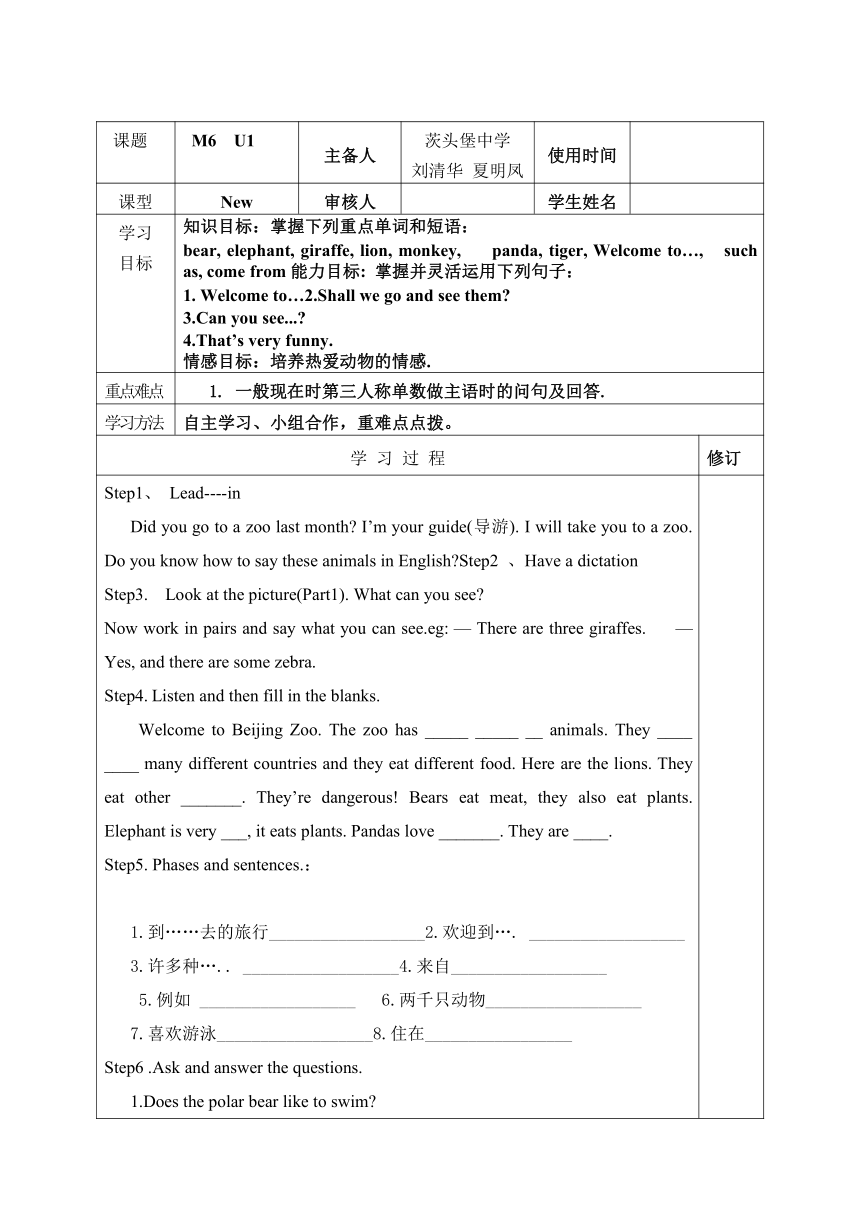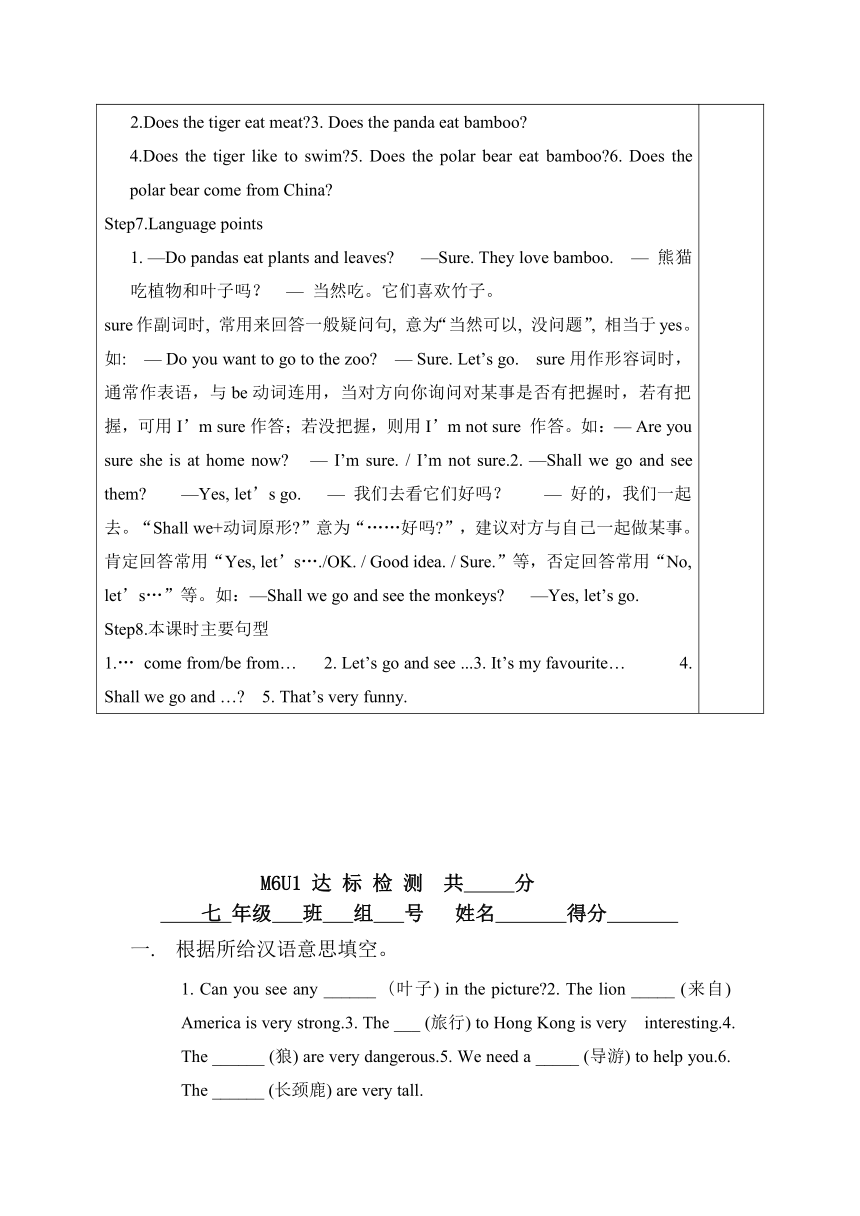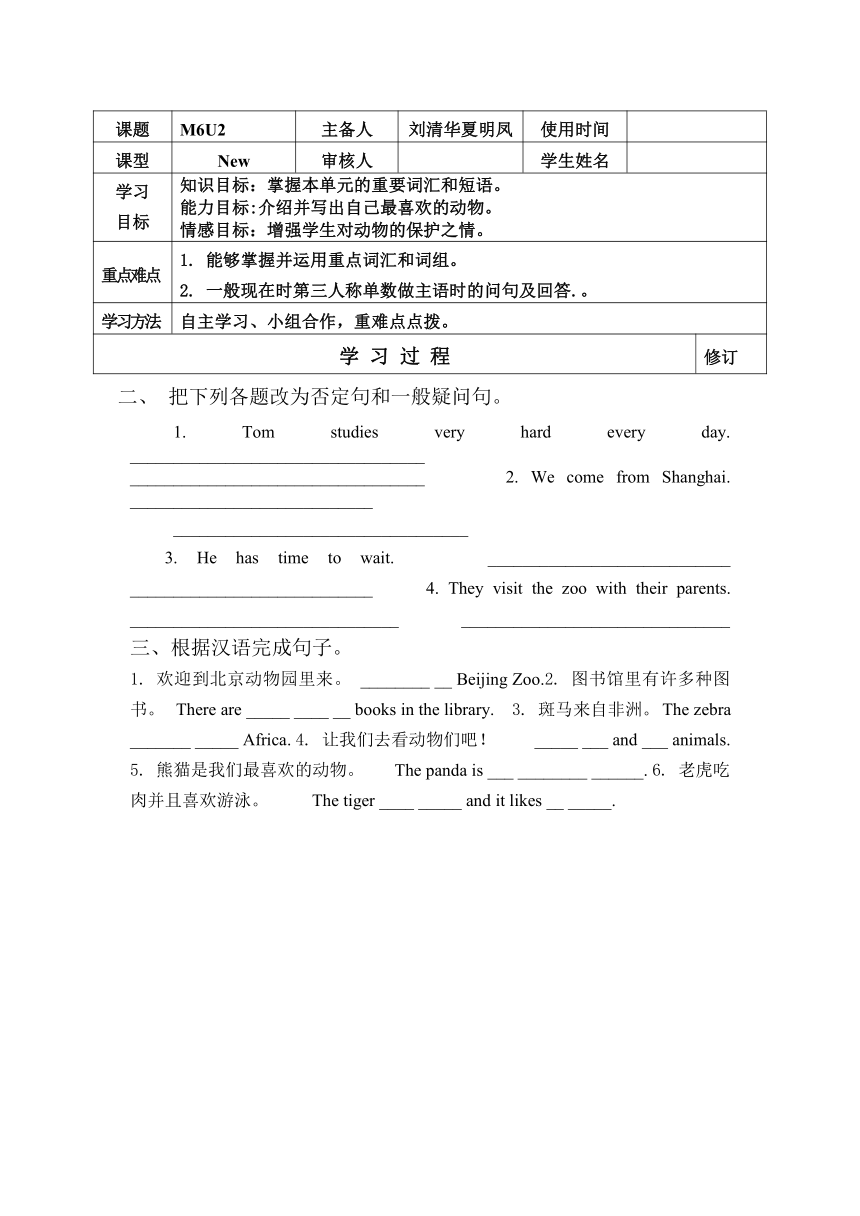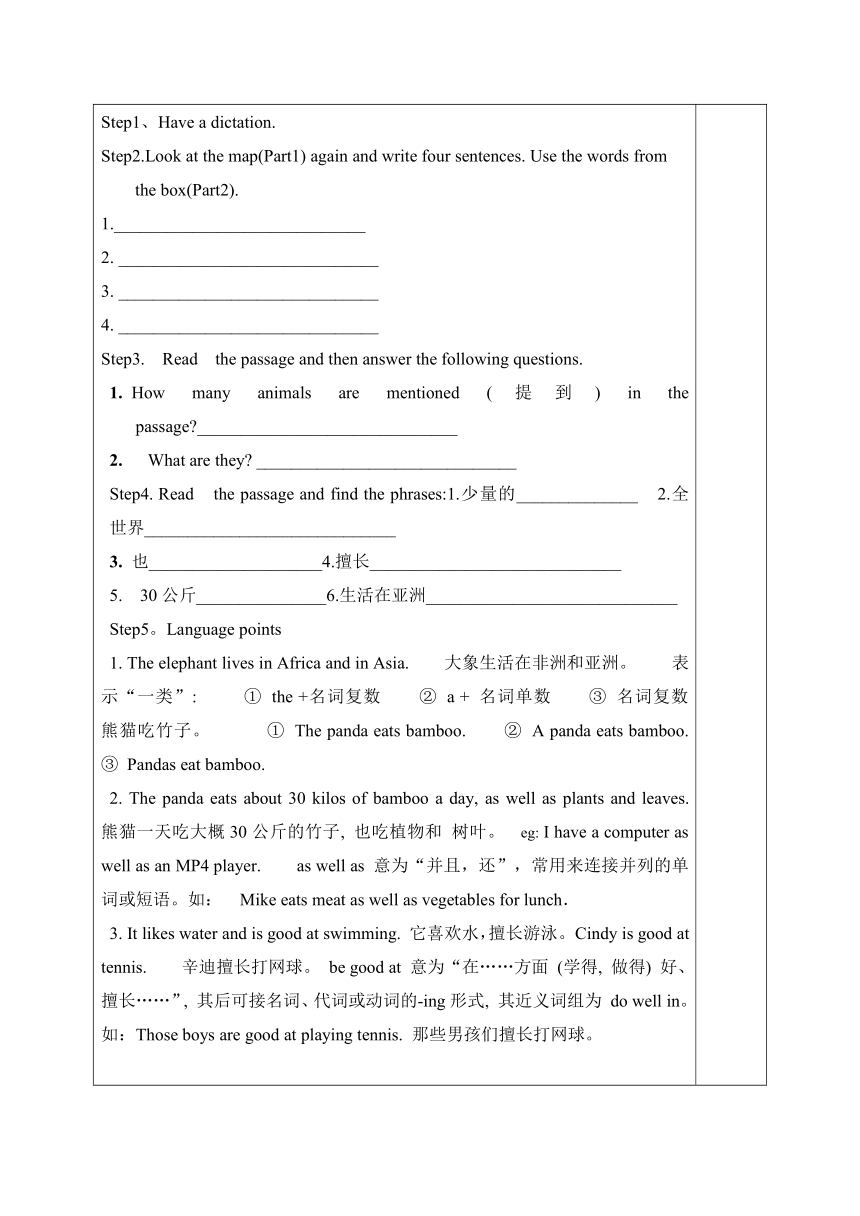Module 6 A trip to the zoo>Unit 1 Does it eat meat?导学案(3课时)
文档属性
| 名称 | Module 6 A trip to the zoo>Unit 1 Does it eat meat?导学案(3课时) |

|
|
| 格式 | zip | ||
| 文件大小 | 23.3KB | ||
| 资源类型 | 教案 | ||
| 版本资源 | 外研版 | ||
| 科目 | 英语 | ||
| 更新时间 | 2015-10-21 22:37:42 | ||
图片预览




文档简介
课题 M6 U1 主备人 茨头堡中学刘清华 夏明凤 使用时间
课型 New 审核人 学生姓名
学习目标 知识目标:掌握下列重点单词和短语:bear, elephant, gira ( http: / / www.21cnjy.com )ffe, lion, monkey, panda, tiger, Welcome to…, such as, come from能力目标: 掌握并灵活运用下列句子: 1. Welcome to…2.Shall we go and see them 3.Can you see... 4.That’s very funny.情感目标:培养热爱动物的情感.
重点难点 一般现在时第三人称单数做主语时的问句及回答.
学习方法 自主学习、小组合作,重难点点拨。
学 习 过 程 修订
Step1、 Lead----in Did you go to a zo ( http: / / www.21cnjy.com )o last month I’m your guide(导游). I will take you to a zoo. Do you know how to say these animals in English Step2 、Have a dictationStep3. Look at the picture(Part1). What can you see Now work in pairs and ( http: / / www.21cnjy.com ) say what you can see.eg: — There are three giraffes. — Yes, and there are some zebra.Step4. Listen and then fill in the blanks.Welcome to Be ( http: / / www.21cnjy.com )ijing Zoo. The zoo has _____ _____ __ animals. They ____ ____ many different countries and they eat different food. Here are the lions. They eat other _______. They’re dangerous! Bears eat meat, they also eat plants. Elephant is very ___, it eats plants. Pandas love _______. They are ____. Step5. Phases and sentences.:1.到……去的旅行__________________2.欢迎到…. __________________3.许多种….. __________________4.来自__________________5.例如 __________________ 6.两千只动物__________________7.喜欢游泳__________________8.住在_________________Step6 .Ask and answer the questions.1.Does the polar bear like to swim 2.Does the tiger eat meat 3. Does the panda eat bamboo 4.Does the tiger li ( http: / / www.21cnjy.com )ke to swim 5. Does the polar bear eat bamboo 6. Does the polar bear come from China Step7.Language points1. —Do pandas eat ( http: / / www.21cnjy.com ) plants and leaves —Sure. They love bamboo. — 熊猫吃植物和叶子吗? — 当然吃。它们喜欢竹子。sure作副词时, 常用来回答一般 ( http: / / www.21cnjy.com )疑问句, 意为“当然可以, 没问题”, 相当于yes。如: — Do you want to go to the zoo — Sure. Let’s go. sure用作形容词时,通常作表语,与be动词连用,当对方向你询问对某事是否有把握时,若有把握,可用I’m sure作答;若没把握,则用I’m not sure 作答。如:— Are you sure she is at home now — I’m sure. / I’m not sure.2. —Shall we go and see them —Yes, let’s go. — 我们去看它们好吗? — 好的,我们一起去。“Shall we+动词原形 ”意为“……好吗 ”,建议对方与自己一起做某事。 肯定回答常用“Yes, let’s…./OK. / Good idea. / Sure.”等,否定回答常用“No, let’s…”等。如:—Shall we go and see the monkeys —Yes, let’s go. Step8.本课时主要句型1.… come from/be from… 2. Let’s go and see ...3. It’s my favourite… 4. Shall we go and … 5. That’s very funny.
M6U1 达 标 检 测 共 分
七 年级 班 组 号 姓名 得分
一. 根据所给汉语意思填空。
1. Can you se ( http: / / www.21cnjy.com )e any ______ (叶子) in the picture 2. The lion _____ (来自) America is very strong.3. The ___ (旅行) to Hong Kong is very interesting.4. The ______ (狼) are very dangerous.5. We need a _____ (导游) to help you.6. The ______ (长颈鹿) are very tall.
二、 把下列各题改为否定句和一般疑问句。
1. Tom studi ( http: / / www.21cnjy.com )es very hard every day. __________________________________ __________________________________ 2. We come from Shanghai. ____________________________
__________________________________
3. He has time to w ( http: / / www.21cnjy.com )ait. ____________________________ ____________________________ 4. They visit the zoo with their parents. _______________________________ _______________________________ 三、根据汉语完成句子。
1. 欢迎到北京动物园里来。 ________ __ Beijing Zoo.2. 图书馆里有许多种图书。 There are _____ ____ __ books in the library. 3. 斑马来自非洲。 The zebra _______ _____ Africa. 4. 让我们去看动物们吧! _____ ___ and ___ animals. 5. 熊猫是我们最喜欢的动物。 The panda is ___ ________ ______. 6. 老虎吃肉并且喜欢游泳。 The tiger ____ _____ and it likes __ _____.
课题 M6U2 主备人 刘清华夏明凤 使用时间
课型 New 审核人 学生姓名
学习目标 知识目标:掌握本单元的重要词汇和短语。能力目标:介绍并写出自己最喜欢的动物。情感目标:增强学生对动物的保护之情。
重点难点 能够掌握并运用重点词汇和词组。一般现在时第三人称单数做主语时的问句及回答.。
学习方法 自主学习、小组合作,重难点点拨。
学 习 过 程 修订
Step1、Have a dictation.Step2.Look at the ( http: / / www.21cnjy.com ) map(Part1) again and write four sentences. Use the words from the box(Part2).1._____________________________2. ______________________________3. ______________________________4. ______________________________Step3. Read the passage and then answer the following questions.How many animals are ( http: / / www.21cnjy.com ) mentioned (提到) in the passage ______________________________ What are they ______________________________Step4. Read the p ( http: / / www.21cnjy.com )assage and find the phrases:1.少量的______________ 2.全世界_____________________________也____________________4.擅长_____________________________5. 30公斤_______________6.生活在亚洲_____________________________Step5。Language points1. The elephant liv ( http: / / www.21cnjy.com )es in Africa and in Asia. 大象生活在非洲和亚洲。 表示“一类”: ① the +名词复数 ② a + 名词单数 ③ 名词复数 熊猫吃竹子。 ① The panda eats bamboo. ② A panda eats bamboo. ③ Pandas eat bamboo. 2. The panda ea ( http: / / www.21cnjy.com )ts about 30 kilos of bamboo a day, as well as plants and leaves. 熊猫一天吃大概30公斤的竹子, 也吃植物和 树叶。 eg: I have a computer as well as an MP4 player. as well as 意为“并且,还”,常用来连接并列的单词或短语。如: Mike eats meat as well as vegetables for lunch. 3. It likes water a ( http: / / www.21cnjy.com )nd is good at swimming. 它喜欢水,擅长游泳。 Cindy is good at tennis. 辛迪擅长打网球。 be good at 意为“在……方面 (学得, 做得) 好、擅长……”, 其后可接名词、代词或动词的-ing形式, 其近义词组为 do well in。如:Those boys are good at playing tennis. 那些男孩们擅长打网球。
M6U2 达 标 检 测 共 分
七年级 班 组 号 姓名 得分
根据汉意提示完成单词。
1. What animals live ( http: / / www.21cnjy.com )in ____ (亚洲) 2. Panda eat plants, leaves and ________ (竹子).3. The zebra is an _______ (非洲的) animal.4. Does the giraffe eat _____ (草) 5. This monkey is from _______ (美洲).6. The trees are thick with ______ (树叶). 二.连词成句。
1. tiger, swi ( http: / / www.21cnjy.com )mming, good, the, at, is ____________________________ 2. Asian, the, is, zebra, not, an, animal _____________________________ 3. elephants, meat, do, eat, not _____________________________ 4. American, from, Americans, come _____________________________ 5. zoo, in, there are, 200, panda, about _____________________________ 三、 按要求完成句子
1. They study in ( http: / / www.21cnjy.com ) high school. (就划线部分提问) ______ ___ they study 2. The panda eats bamboo. (改为复数句子) The ______ eat ________. 3. They are American girls. (改为单数句子) ___ __ __ American girl. 4. The kangaroo comes from Australia. (改为同义句) The kangaroo __ ____ Australia.四、根据汉语完成句子。
1. 全世界的人都认识他。 Peopl ( http: / / www.21cnjy.com )e ________________ know him.2. 这只大象来自亚洲吗?是的。 ____ the elephant ___________ Yes, it is.3. 他住在非洲吗?不是。 ______he ____________ No, _________.4. 这只狼是美洲的吗?不是。 ___ the wolf _________ No, ______.
课题 M6U3 主备人 刘清华夏明凤 使用时间
课型 New 审核人 学生姓名
学习目标 知识目标:掌握本单元的重要词汇和短语。能力目标:介绍并写出自己最喜欢的动物。情感目标:增强学生对动物的保护之情。
重点难点 1.对整个模块单词、短语、固定搭配、句式及语法知识点总结复习。2. 一般现在时第三人称单数做主语时的问句及回答.。
学习方法 自主学习、小组合作,重难点点拨。
学 习 过 程 修订
Step1、 Examples in this module:1. — Is the camel Af ( http: / / www.21cnjy.com )rican — Yes, it is. / No, it isn’t. — Does the camel eat fruit — Yes, it does. / No, it doesn’t. 2. — Is the wolf European — Yes, it is. / No, it isn’t. — Does the wolf eat fruit — Yes, it does. / No, it doesn’t.Step2. Grammar1.当主语是第三人称单数,表示经常性、习惯性 ( http: / / www.21cnjy.com )的行为时,我们这样表达: She speaks English. He lives far away from school.如果表示不常做某事,该怎样表达呢?她不说英语。She doesn’t speak English.他住地离学校不远。He doesn’t live far away from school.2.总结:主语是第三人称单数的行为动词的一般现 ( http: / / www.21cnjy.com )在时否定形式是在行为动词前加doesn’t (does not ),这时要注意把谓语动词还原为动词原形。试比较肯定与否定句中行为动词形式的变化:肯定:He gets up very early. 他起床很早。否定:He doesn’t get up very early. 他起床不很早。如果要问别人是否经常做某事,我们要 采用下面的表达方式:—Does the panda eat meat 熊猫吃肉吗?—No, it doesn’t. 不,它不吃。—Does it eat bamboo 它吃竹子吗?—Yes, it does. 是的,吃。从以上例子可以看出,行为动词的第三人称单数一般现在时疑问形式是在句首加助动词does ,而加does之后,后面的 谓语动词像否定句一样也要用原形。试比较:肯定:He gets up very early. 他起床很早。疑问:Does he get up very early 他起床很早吗?3.现在把行为动词第三人称单数的各种句式总结如下:肯定句:主语+动词的第三人称单数形式否定句:主语+doesn’t +动词原形疑问句:Does+主语+动词原形?肯定回答:Yes, 主语+does.否定回答:No, 主语+ doesn’t.
M6 Unit1达 标 检 测 共 分
七年级 班 组 号 姓名 得分
一、 用括号内所给动词的适当形式填空。
1. The monkey _____ (like) bananas. 2. Lucy ___________ (not visit) Japan. 3. ____ Tiger ____ (live) in the wild in China 4. The worker _____ (give) the lion ten kilos of meat a day. 5. Where ____ the wolf _____ (come) from 二、 句型转换。
1. My favourite anim ( http: / / www.21cnjy.com )al is the elephant. (对划线部分提问) _____ _ your favourite animal 2. Hand often goes to see his grandparents on Saturdays. (改为一般疑问句,并作否定回答) ____ Hand often __ to see his grandparents on Saturdays No, he _______. 3. Our school has two thousand students. (改为同义句) _____ ___ two thousand students in our school. 4. The panda is from China. (改为同义句) The panda ______ _____ China. 5. The tiger eats 5 kilos of meat a day.(对划线部分提问) ____ _____ meat does the tiger eat a day
课型 New 审核人 学生姓名
学习目标 知识目标:掌握下列重点单词和短语:bear, elephant, gira ( http: / / www.21cnjy.com )ffe, lion, monkey, panda, tiger, Welcome to…, such as, come from能力目标: 掌握并灵活运用下列句子: 1. Welcome to…2.Shall we go and see them 3.Can you see... 4.That’s very funny.情感目标:培养热爱动物的情感.
重点难点 一般现在时第三人称单数做主语时的问句及回答.
学习方法 自主学习、小组合作,重难点点拨。
学 习 过 程 修订
Step1、 Lead----in Did you go to a zo ( http: / / www.21cnjy.com )o last month I’m your guide(导游). I will take you to a zoo. Do you know how to say these animals in English Step2 、Have a dictationStep3. Look at the picture(Part1). What can you see Now work in pairs and ( http: / / www.21cnjy.com ) say what you can see.eg: — There are three giraffes. — Yes, and there are some zebra.Step4. Listen and then fill in the blanks.Welcome to Be ( http: / / www.21cnjy.com )ijing Zoo. The zoo has _____ _____ __ animals. They ____ ____ many different countries and they eat different food. Here are the lions. They eat other _______. They’re dangerous! Bears eat meat, they also eat plants. Elephant is very ___, it eats plants. Pandas love _______. They are ____. Step5. Phases and sentences.:1.到……去的旅行__________________2.欢迎到…. __________________3.许多种….. __________________4.来自__________________5.例如 __________________ 6.两千只动物__________________7.喜欢游泳__________________8.住在_________________Step6 .Ask and answer the questions.1.Does the polar bear like to swim 2.Does the tiger eat meat 3. Does the panda eat bamboo 4.Does the tiger li ( http: / / www.21cnjy.com )ke to swim 5. Does the polar bear eat bamboo 6. Does the polar bear come from China Step7.Language points1. —Do pandas eat ( http: / / www.21cnjy.com ) plants and leaves —Sure. They love bamboo. — 熊猫吃植物和叶子吗? — 当然吃。它们喜欢竹子。sure作副词时, 常用来回答一般 ( http: / / www.21cnjy.com )疑问句, 意为“当然可以, 没问题”, 相当于yes。如: — Do you want to go to the zoo — Sure. Let’s go. sure用作形容词时,通常作表语,与be动词连用,当对方向你询问对某事是否有把握时,若有把握,可用I’m sure作答;若没把握,则用I’m not sure 作答。如:— Are you sure she is at home now — I’m sure. / I’m not sure.2. —Shall we go and see them —Yes, let’s go. — 我们去看它们好吗? — 好的,我们一起去。“Shall we+动词原形 ”意为“……好吗 ”,建议对方与自己一起做某事。 肯定回答常用“Yes, let’s…./OK. / Good idea. / Sure.”等,否定回答常用“No, let’s…”等。如:—Shall we go and see the monkeys —Yes, let’s go. Step8.本课时主要句型1.… come from/be from… 2. Let’s go and see ...3. It’s my favourite… 4. Shall we go and … 5. That’s very funny.
M6U1 达 标 检 测 共 分
七 年级 班 组 号 姓名 得分
一. 根据所给汉语意思填空。
1. Can you se ( http: / / www.21cnjy.com )e any ______ (叶子) in the picture 2. The lion _____ (来自) America is very strong.3. The ___ (旅行) to Hong Kong is very interesting.4. The ______ (狼) are very dangerous.5. We need a _____ (导游) to help you.6. The ______ (长颈鹿) are very tall.
二、 把下列各题改为否定句和一般疑问句。
1. Tom studi ( http: / / www.21cnjy.com )es very hard every day. __________________________________ __________________________________ 2. We come from Shanghai. ____________________________
__________________________________
3. He has time to w ( http: / / www.21cnjy.com )ait. ____________________________ ____________________________ 4. They visit the zoo with their parents. _______________________________ _______________________________ 三、根据汉语完成句子。
1. 欢迎到北京动物园里来。 ________ __ Beijing Zoo.2. 图书馆里有许多种图书。 There are _____ ____ __ books in the library. 3. 斑马来自非洲。 The zebra _______ _____ Africa. 4. 让我们去看动物们吧! _____ ___ and ___ animals. 5. 熊猫是我们最喜欢的动物。 The panda is ___ ________ ______. 6. 老虎吃肉并且喜欢游泳。 The tiger ____ _____ and it likes __ _____.
课题 M6U2 主备人 刘清华夏明凤 使用时间
课型 New 审核人 学生姓名
学习目标 知识目标:掌握本单元的重要词汇和短语。能力目标:介绍并写出自己最喜欢的动物。情感目标:增强学生对动物的保护之情。
重点难点 能够掌握并运用重点词汇和词组。一般现在时第三人称单数做主语时的问句及回答.。
学习方法 自主学习、小组合作,重难点点拨。
学 习 过 程 修订
Step1、Have a dictation.Step2.Look at the ( http: / / www.21cnjy.com ) map(Part1) again and write four sentences. Use the words from the box(Part2).1._____________________________2. ______________________________3. ______________________________4. ______________________________Step3. Read the passage and then answer the following questions.How many animals are ( http: / / www.21cnjy.com ) mentioned (提到) in the passage ______________________________ What are they ______________________________Step4. Read the p ( http: / / www.21cnjy.com )assage and find the phrases:1.少量的______________ 2.全世界_____________________________也____________________4.擅长_____________________________5. 30公斤_______________6.生活在亚洲_____________________________Step5。Language points1. The elephant liv ( http: / / www.21cnjy.com )es in Africa and in Asia. 大象生活在非洲和亚洲。 表示“一类”: ① the +名词复数 ② a + 名词单数 ③ 名词复数 熊猫吃竹子。 ① The panda eats bamboo. ② A panda eats bamboo. ③ Pandas eat bamboo. 2. The panda ea ( http: / / www.21cnjy.com )ts about 30 kilos of bamboo a day, as well as plants and leaves. 熊猫一天吃大概30公斤的竹子, 也吃植物和 树叶。 eg: I have a computer as well as an MP4 player. as well as 意为“并且,还”,常用来连接并列的单词或短语。如: Mike eats meat as well as vegetables for lunch. 3. It likes water a ( http: / / www.21cnjy.com )nd is good at swimming. 它喜欢水,擅长游泳。 Cindy is good at tennis. 辛迪擅长打网球。 be good at 意为“在……方面 (学得, 做得) 好、擅长……”, 其后可接名词、代词或动词的-ing形式, 其近义词组为 do well in。如:Those boys are good at playing tennis. 那些男孩们擅长打网球。
M6U2 达 标 检 测 共 分
七年级 班 组 号 姓名 得分
根据汉意提示完成单词。
1. What animals live ( http: / / www.21cnjy.com )in ____ (亚洲) 2. Panda eat plants, leaves and ________ (竹子).3. The zebra is an _______ (非洲的) animal.4. Does the giraffe eat _____ (草) 5. This monkey is from _______ (美洲).6. The trees are thick with ______ (树叶). 二.连词成句。
1. tiger, swi ( http: / / www.21cnjy.com )mming, good, the, at, is ____________________________ 2. Asian, the, is, zebra, not, an, animal _____________________________ 3. elephants, meat, do, eat, not _____________________________ 4. American, from, Americans, come _____________________________ 5. zoo, in, there are, 200, panda, about _____________________________ 三、 按要求完成句子
1. They study in ( http: / / www.21cnjy.com ) high school. (就划线部分提问) ______ ___ they study 2. The panda eats bamboo. (改为复数句子) The ______ eat ________. 3. They are American girls. (改为单数句子) ___ __ __ American girl. 4. The kangaroo comes from Australia. (改为同义句) The kangaroo __ ____ Australia.四、根据汉语完成句子。
1. 全世界的人都认识他。 Peopl ( http: / / www.21cnjy.com )e ________________ know him.2. 这只大象来自亚洲吗?是的。 ____ the elephant ___________ Yes, it is.3. 他住在非洲吗?不是。 ______he ____________ No, _________.4. 这只狼是美洲的吗?不是。 ___ the wolf _________ No, ______.
课题 M6U3 主备人 刘清华夏明凤 使用时间
课型 New 审核人 学生姓名
学习目标 知识目标:掌握本单元的重要词汇和短语。能力目标:介绍并写出自己最喜欢的动物。情感目标:增强学生对动物的保护之情。
重点难点 1.对整个模块单词、短语、固定搭配、句式及语法知识点总结复习。2. 一般现在时第三人称单数做主语时的问句及回答.。
学习方法 自主学习、小组合作,重难点点拨。
学 习 过 程 修订
Step1、 Examples in this module:1. — Is the camel Af ( http: / / www.21cnjy.com )rican — Yes, it is. / No, it isn’t. — Does the camel eat fruit — Yes, it does. / No, it doesn’t. 2. — Is the wolf European — Yes, it is. / No, it isn’t. — Does the wolf eat fruit — Yes, it does. / No, it doesn’t.Step2. Grammar1.当主语是第三人称单数,表示经常性、习惯性 ( http: / / www.21cnjy.com )的行为时,我们这样表达: She speaks English. He lives far away from school.如果表示不常做某事,该怎样表达呢?她不说英语。She doesn’t speak English.他住地离学校不远。He doesn’t live far away from school.2.总结:主语是第三人称单数的行为动词的一般现 ( http: / / www.21cnjy.com )在时否定形式是在行为动词前加doesn’t (does not ),这时要注意把谓语动词还原为动词原形。试比较肯定与否定句中行为动词形式的变化:肯定:He gets up very early. 他起床很早。否定:He doesn’t get up very early. 他起床不很早。如果要问别人是否经常做某事,我们要 采用下面的表达方式:—Does the panda eat meat 熊猫吃肉吗?—No, it doesn’t. 不,它不吃。—Does it eat bamboo 它吃竹子吗?—Yes, it does. 是的,吃。从以上例子可以看出,行为动词的第三人称单数一般现在时疑问形式是在句首加助动词does ,而加does之后,后面的 谓语动词像否定句一样也要用原形。试比较:肯定:He gets up very early. 他起床很早。疑问:Does he get up very early 他起床很早吗?3.现在把行为动词第三人称单数的各种句式总结如下:肯定句:主语+动词的第三人称单数形式否定句:主语+doesn’t +动词原形疑问句:Does+主语+动词原形?肯定回答:Yes, 主语+does.否定回答:No, 主语+ doesn’t.
M6 Unit1达 标 检 测 共 分
七年级 班 组 号 姓名 得分
一、 用括号内所给动词的适当形式填空。
1. The monkey _____ (like) bananas. 2. Lucy ___________ (not visit) Japan. 3. ____ Tiger ____ (live) in the wild in China 4. The worker _____ (give) the lion ten kilos of meat a day. 5. Where ____ the wolf _____ (come) from 二、 句型转换。
1. My favourite anim ( http: / / www.21cnjy.com )al is the elephant. (对划线部分提问) _____ _ your favourite animal 2. Hand often goes to see his grandparents on Saturdays. (改为一般疑问句,并作否定回答) ____ Hand often __ to see his grandparents on Saturdays No, he _______. 3. Our school has two thousand students. (改为同义句) _____ ___ two thousand students in our school. 4. The panda is from China. (改为同义句) The panda ______ _____ China. 5. The tiger eats 5 kilos of meat a day.(对划线部分提问) ____ _____ meat does the tiger eat a day
同课章节目录
- Starte
- Module 1 My teacher and my friends
- Module 2 My English lesson
- Module 3 My English book
- Module 4 My everyday life
- Module 1 My classmates
- Unit 1 Nice to meet you.
- Unit 2 I'm Wang Lingling and I'm thirteen years ol
- Unit 3 Language in use.
- Module 2 My family
- Unit 1 Is this your mum?
- Unit 2 These are my parents.
- Unit 3 Language in use.
- Module 3 My school
- Unit 1 There are thirty students in my class.
- Unit 2 The library is on the left of the playgroun
- Unit 3 Language in use.
- Module 4 Healthy food
- Unit 1 We've got lots of apples.
- Unit 2 Is your food and drink healthy?
- Unit 3 Language in use.
- Module 5 My school day
- Unit 1 I love history.
- Unit 2 We start work at nine o'clock.
- Unit 3 Language in use.
- Revision module A
- Module 6 A trip to the zoo
- Unit 1 Does it eat meat?
- Unit 2 The tiger lives in Asia.
- Unit 3 Language in use.
- Module 7 Computers
- Unit 1 How do I write my homework on the computer?
- Unit 2 When do you use a computer?
- Unit 3 Language in use.
- Module 8 Choosing presents
- Unit 1 I always like birthday parties.
- Unit 2 She often goes to concerts.
- Unit 3 Language in use.
- Module 9 People and places
- Unit 1 We're enjoying the school trip a lot.
- Unit 2 They're waiting for buses or trains.
- Unit 3 Language in use.
- Module 10 Spring Festival
- Unit 1 Are you getting ready for Spring Festival?
- Unit 2 My mother's cleaning our houses and sweepin
- Unit 3 Language in use.
- Revision module B
